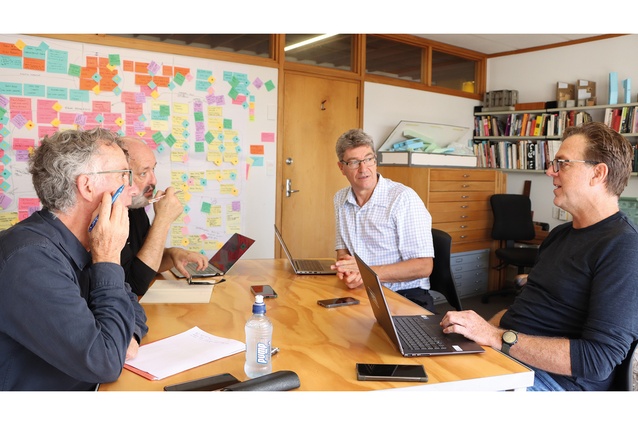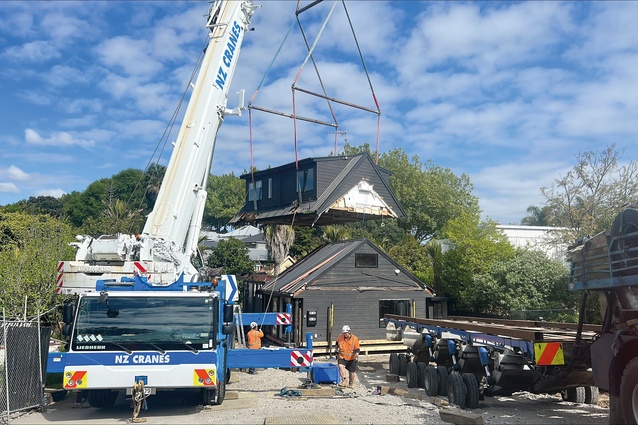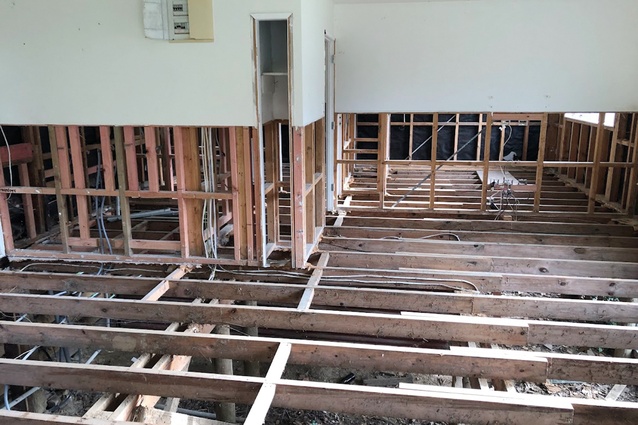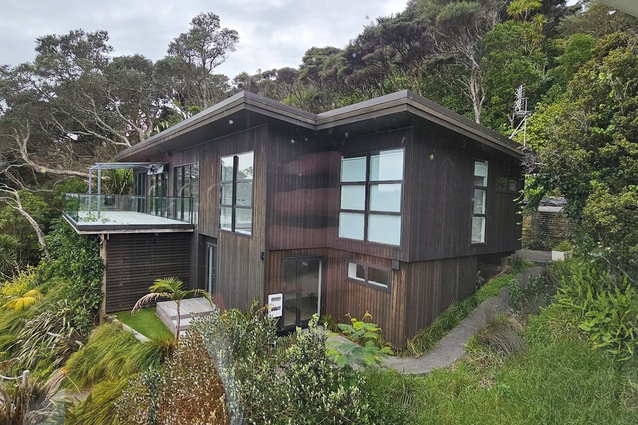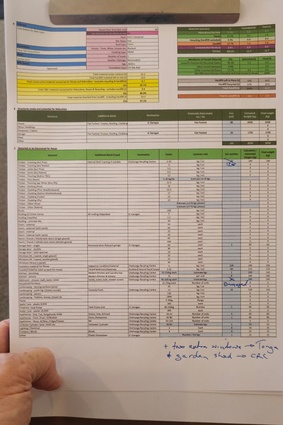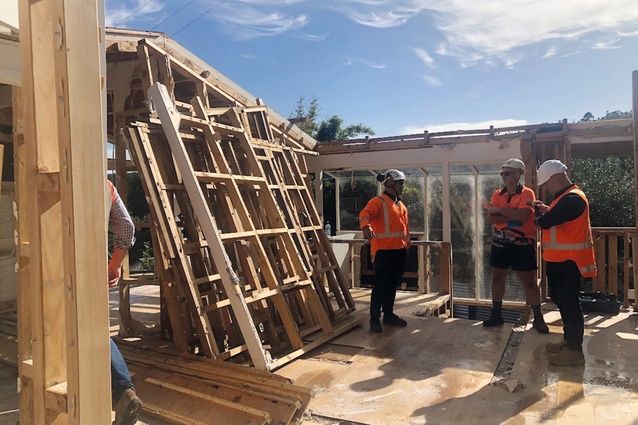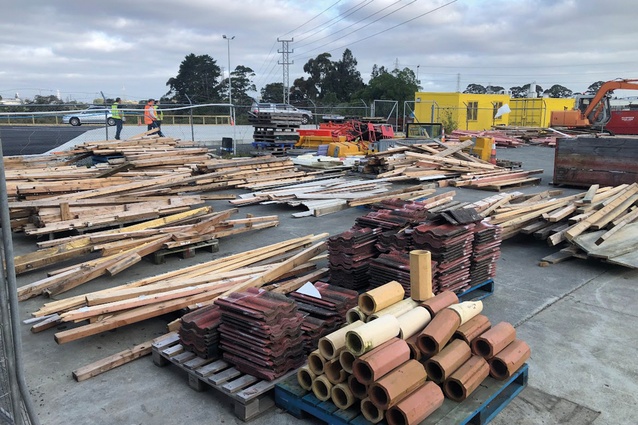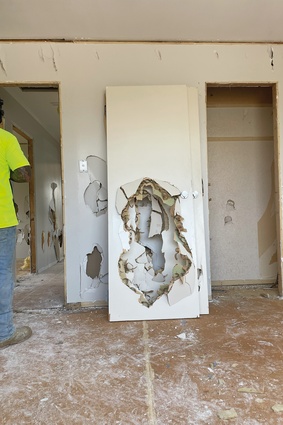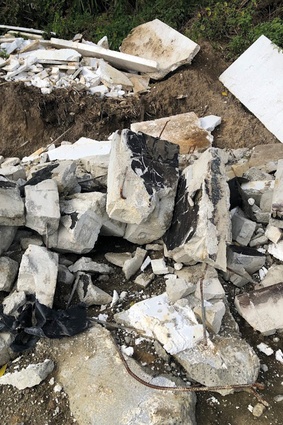After the rain
In part one of a six-part series, Andrew Barrie speaks to Claude Dewerse and Mike LeRoy-Dyson about their roles, and the ground-breaking methods they are developing, in disposing of 1200 disaster-compromised houses across Auckland city.
In wrestling with the fast-escalating challenges of delivering a low-carbon future, most Kiwi architects will have cottoned on to the associated need to transition to a circular economy. The local scene has, as yet, relatively few examples of this approach: among them Ged Finch’s reusable X-Frame system, Athfield Architects’ designed-for-disassembly Kaipātiki Eco Hub, and the Living Building Challenge’s requirement for the minimisation and re-use of construction waste. But, in addition to dealing with the waste generated by current projects, we also need to grapple with what happens at the end of a building’s life. As with other current shifts in design approach, the driving force may as yet be more demand from clients than leadership by architects.
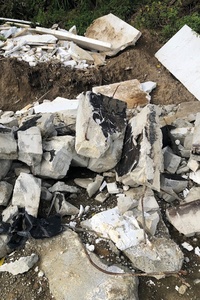
In 2022, Auckland Council adopted a policy that forbade straight demolition of its buildings, instead mandating deconstruction and waste-reduction efforts. Firms that were interested in future council contracts put their names forward and had to demonstrate either a track record or the means to develop the required capacity and expertise. The process produced a ‘deconstruction panel’ of 11 contractors. Ranging from large demolition contractors to smaller material-recovery firms, they represented varying business models — some have yards where they can sell recovered materials, some give them away and so on. Firms from the panel soon became involved in civic projects, such as the recent deconstruction of the library in Point Chevalier and the current redevelopment of the Northcote and Avondale Community Centres.
Not long after this, on Auckland’s Anniversary weekend in January of 2023, an atmospheric river dumped a month’s worth of rain on the city in a day. Scenes of a kind Aucklanders had witnessed only on TV news reports from the provinces played out on the city’s busy motorways and suburban streets. For some, notably damp and disappointed Elton John fans, the rain was merely an irritation. Those in other parts of the city faced unprecedented flooding that led to chaotic and surreal scenes: buses full of water, cars floating down streets, flooded airport terminals and, tragically, four deaths. It would become New Zealand’s costliest weather event and, for many Aucklanders, would be the moment when the effects of climate change literally came to town.
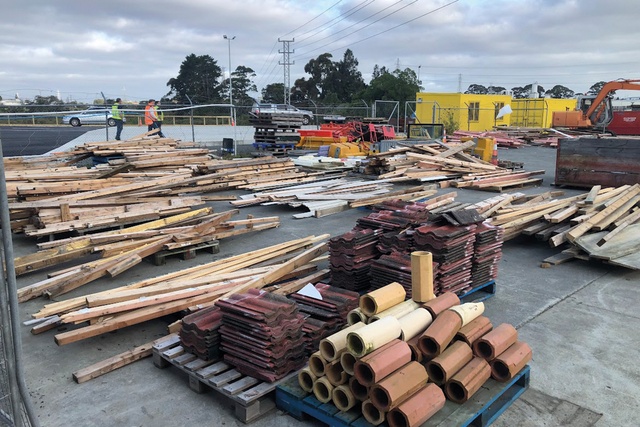
In the wake of the disaster, Auckland Council began a project with the Government to buy out home-owners that faced ongoing “intolerable risk to life” and whose houses shouldn’t be where they were. Following months of intense negotiations, the Government and the Council announced that they would each stump up $750 million — a total of $1.5 billion to buy out 600 houses. The Council provided additional funding for the clearing of the sites. Meanwhile, though, assessment processes were still ongoing around the city, and the number of houses slated for removal kept climbing and is now just under 1200. The condition of these homes varies widely; some were completely destroyed, some still stand in their flood-impacted state, while most have had their damage repaired by insurance companies. A few, at the top or bottom of now-unstable hillsides, are totally untouched.
The Tāmaki Makaurau Recovery Office was set up as an arm of Auckland Council to coordinate the repair and rebuild efforts on behalf of the Council and the Government. Key parameters were defined by the Council’s own Waste Minimisation and Management Plan, which set the ambitious target of reducing waste to landfill to zero by 2040. To avoid a waste blow-out, the Recovery Office called in circular economy consultant Claude Dewerse and sustainability expert Mike LeRoy-Dyson to oversee the house-removal project. Their task was to work with the deconstruction panel contractors to ensure the pressures of the huge project didn’t prompt a return to the old ways. In disposing of the now-vacant houses, Dewerse and LeRoy-Dyson asked a simple question: How can we do this differently?
Removing a typical house generates about 100 tonnes of waste. (To give a point of reference, the 120,000 tonnes the houses might generate equates to over a month’s worth of the city’s total waste stream.) Discussions of waste reduction often focus on the notion of ‘landfill diversion’ —the percentage of a waste stream that doesn’t end up in landfill but goes to some other use. This metric, however, can be a crude one when measuring demolition waste. A very large portion of waste weight originates in concrete floor slabs, as well as in concrete driveways and landscaping. Concrete from demolition, however, very rarely goes to landfill — landfills charge by weight, which makes dumping concrete prohibitively expensive, and there are companies that receive broken concrete relatively cheaply, crush it and re-sell it as aggregate. In place of the crude diversion measure, Dewerse and LeRoy-Dyson’s programme focuses on a recovery hierarchy:
• relocation of the house;
• re-use of materials or elements for their original use, such as framing timber, floorboards, windows, kitchen cabinetry, appliances and so on;
• recycling of glass, roofing, reinforcing steel and other metals;
• down-cycling — much of the timber from Auckland demolitions, for example, is chipped and used in place of coal to fire a cement plant in Whangārei;
• landfill.
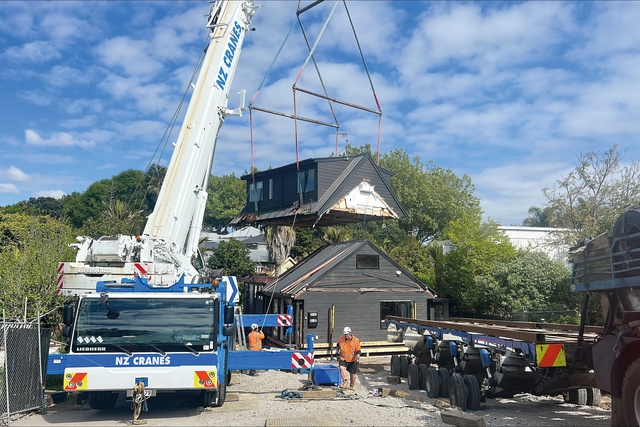
The complexities will be evident. For example, with concrete representing a large proportion of waste weight, high by-weight diversion scores are possible by dealing with just this single material, and chipping timber may divert it from landfill but deposits its carbon into the atmosphere. For Dewerse and LeRoy-Dyson, the goal is to push their 1200 houses as far as possible up this hierarchy.
Dewerse and LeRoy-Dyson’s first task for each house is an initial desktop analysis, through which they generally deem about half as relocatable. Information on these houses is sent to a group of registered organisations, generating offers on about half of them. This is the top of the recovery hierarchy — the house is reused, and the deal reduces the overall cost of cleaning up the site. The houses they assess as movable but for which they have received no offers become subject to negotiation — depending on the house, they offer subsidies of various sizes to the removal crews. Free market hardliners might argue the Council shouldn’t be subsidising businesses, but Dewerse and LeRoy-Dyson point out that the subsidies offered are still less than the cost of deconstruction and produce better outcomes because the houses have been reused. “We’re trying to meet every contractor where they’re at but trying to find places where we can keep pushing them.”
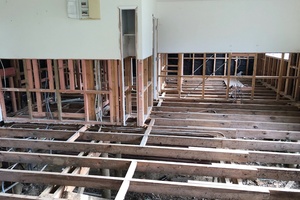
Their innovative approach centres on a spreadsheet they call the Resource Recovery Schedule (RRS). Coming into full use when deconstruction is necessitated, the RRS lists all the various elements included in a typical house and is filled out by the contractors to estimate both how much of each type of material the house contains, and how much can be recovered. Shifting the definition of the task from waste management to resource management, the RRS becomes the starting point for negotiations. Dewerse and LeRoy-Dyson push contractors to increase the volumes recovered and also set about finding destinations for recovered items. “If a house has good stuff in it, we can find places for it to go. We can make it economic.” The RRS also provides a sophisticated measure for resource recovery, where previously the only measures were cost and simple diversion.
In working to increase the volume of material recovered during deconstruction, a key task has been to find a mechanism by which materials — framing timber, for example — can be put back into circulation. Demolition yards have traditionally been relatively small and tended to focus on specialist and higher-value materials for heritage restoration. To absorb the increased flow of materials, Auckland Council has been expanding its network of Community Recycling Centres (CRCs) to gather and sell items from (among others) the deconstruction contractors. The goal is that every Aucklander will be within 20 minutes of a centre. As the CRC network builds and capacity to deal with a range of materials develops, the vision is that they can become alternatives to big-box stores like Bunnings. Aside from the CRCs, Dewerse and LeRoy-Dyson have been helping to connect other social enterprises to the project. Some materials, such as carpets still in good condition, native timbers or joinery, are able to be commercially reused.
Research by the Council has shown that, for every dollar that the Council spends preparing items for re-use rather than recycling or landfill, it returns more than $2 in social value. Dewerse and LeRoy-Dyson point out that, while you might be able to demolish a house and send it to landfill for $30,000, spending a few thousand more is effectively an investment in social outcomes and improvements. They point out that, “the Council, of course, has mandates around social outcomes.”
As architects, we think of buildings as intrinsically valuable but, once a house has been severed from a particular site, the economics shift wildly. The costs of relocation or of removing and cleaning up materials can be very high relative to their re-sale value. This means that the residual value of materials and of whole houses can be very, very low. Dewerse and LeRoy-Dyson cite the example of a house that was about to be relocated when it was struck by wayward teens who smashed the glass in all the windows. Compared with the actions of an earthquake or arsonist, the material damage was relatively slight, but the costs of repair were sufficient that the relocation became uneconomic, and the house was instead deconstructed.
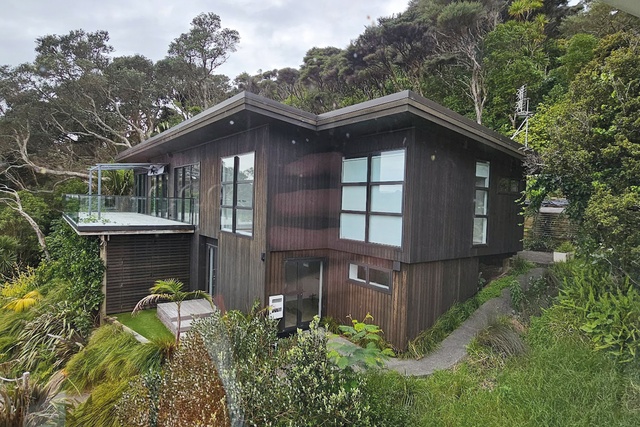
For architects, for whom creating value is a painstaking and time-consuming process, it is astonishing to understand that a handful of stones can entirely erase a building’s worth. Architects, though, might help increase the value of these recovered materials by simply using them in their buildings. “Because, if you’ve got demand,” states Dewerse, “then recovery is a no-brainer.” This will require a shift. Many recovered materials are flawless, but one of the tasks facing designers who want to participate in the circular economy is to set aside the ‘hygiene’ obsession that defined modernism and to develop architectural languages that can absorb imperfection: materials with patina; surfaces that tell stories; and history that is visible.
The range and volume of houses they are dealing with has given Dewerse and LeRoy-Dyson an understanding of the many ways in which designers are unwittingly generating huge future liabilities. One problem they emphasise is the use of polystyrene, particularly through the very common practice of constructing concrete floors over pods or slabs of polystyrene. As noted above, demolition concrete can be fairly easily recycled but, when polystyrene enters the mix, it becomes a contaminant — pieces blow around deconstruction sites, and it takes considerable effort to remove it before the concrete itself can be recycled. “We reckon it’s costing us more to get rid of polystyrene-embedded concrete pads than it costs to build the pads in the first place.” They cite a recent example of a 230m2 house with a waffle slab containing polystyrene pods — the cost of removing and disposing of the slab alone was $46,000. “It wouldn’t surprise me if it cost $46,000 to put that pad down.”
The scale of Dewerse and LeRoy-Dyson’s undertaking and their methodical approach mean their project can serve as a pilot study for what will be an ongoing challenge in Aotearoa. The project is the subject of a study by Paola Boarin and Alessandro Premier of the Future Cities Research Centre and Mike Davis of MĀPIHI Māori and Pacific Housing Research Centre, all of them staff at Te Pare School of Architecture and Planning at Waipapa Taumata Rau University of Auckland. They are seeking to understand the houses as a region-wide ‘urban mine’ from which resources can be extracted over time. They will carry out detailed modelling to develop an accurate understanding of the materials available within various types of house and at the various levels of the re-use hierarchy — in effect, they are backfilling the science and economics on the personal expertise Dewerse and LeRoy-Dyson deploy through the RRS. By extrapolating this information to the whole region, the academics hope to optimise the use of the stream of resources that can be expected as climate change takes its inevitable toll.
Architecture NZ and ArchitectureNow will report further on Dewerse and LeRoy-Dyson’s project in upcoming issues, hoping to share the lessons architects might learn.

